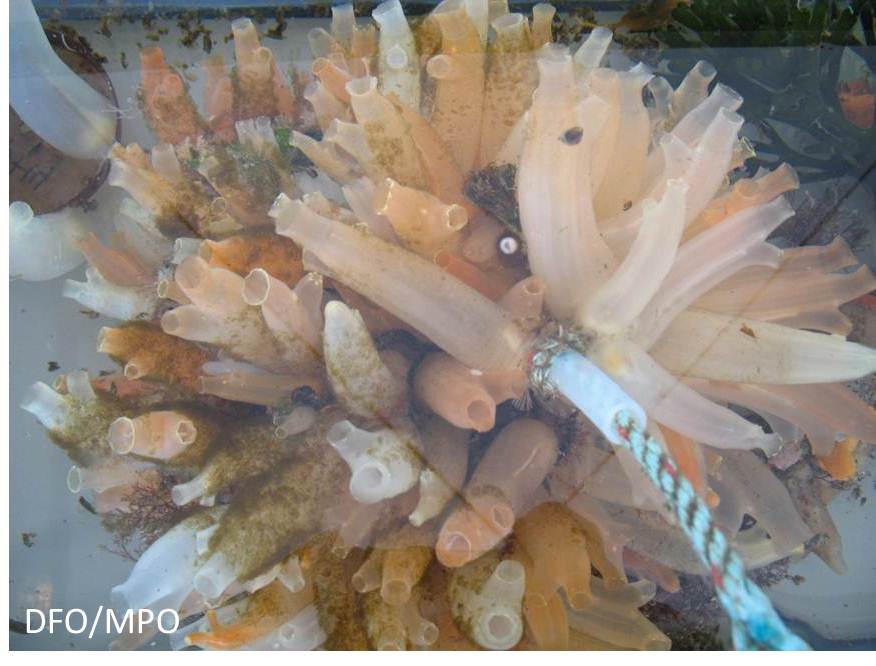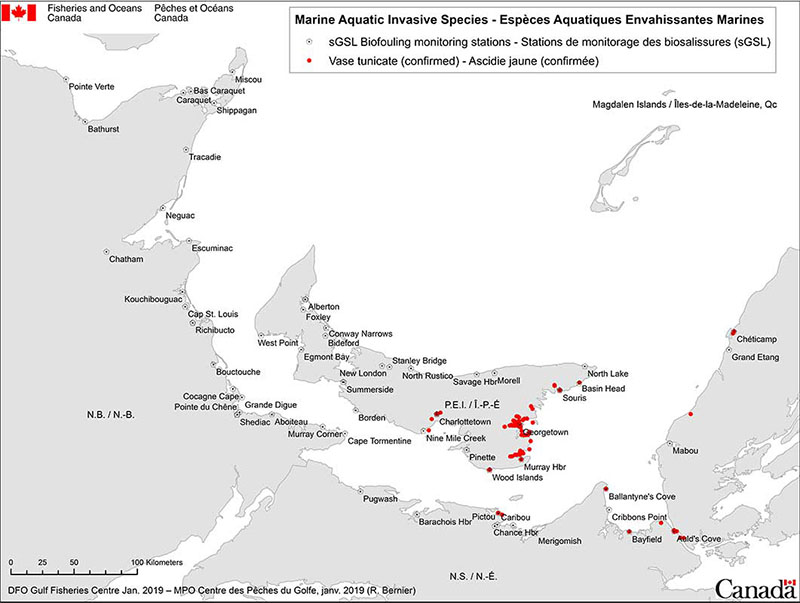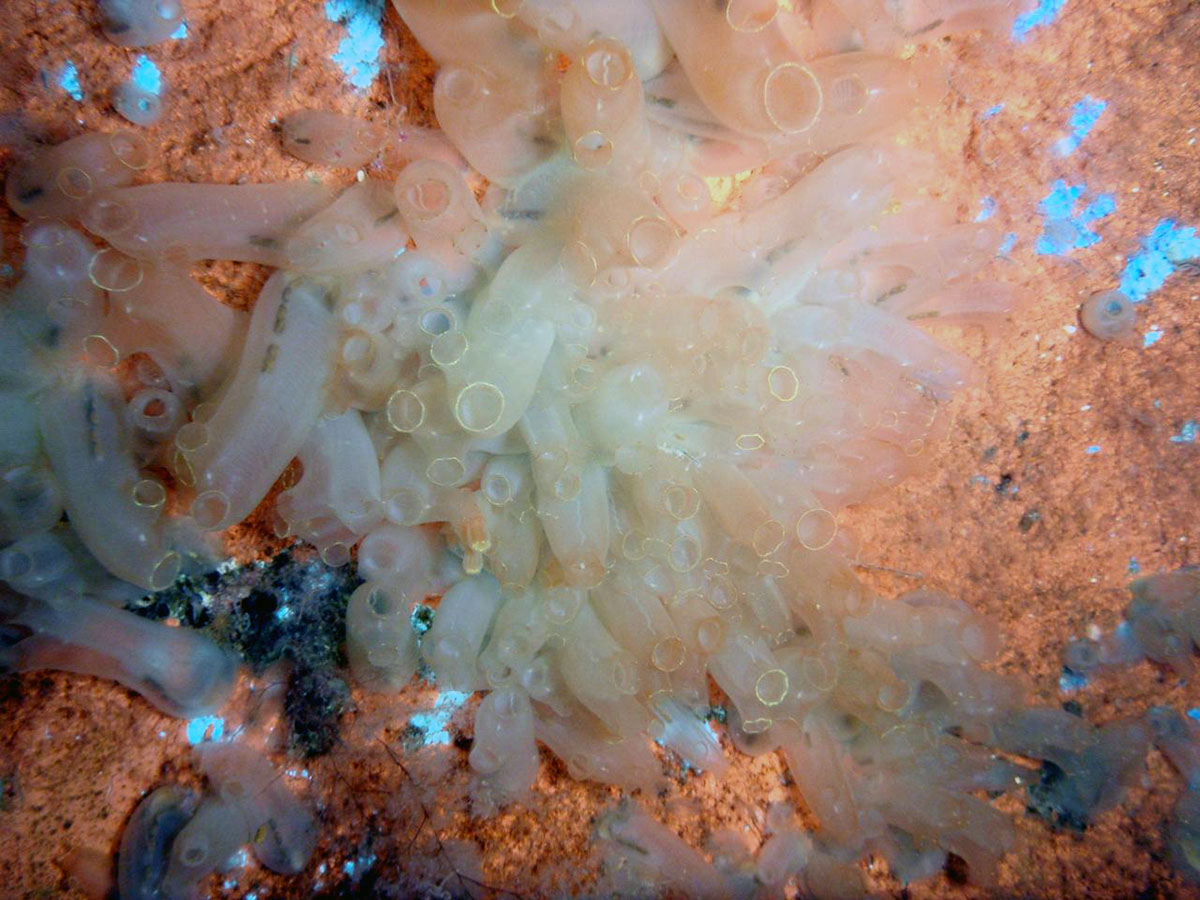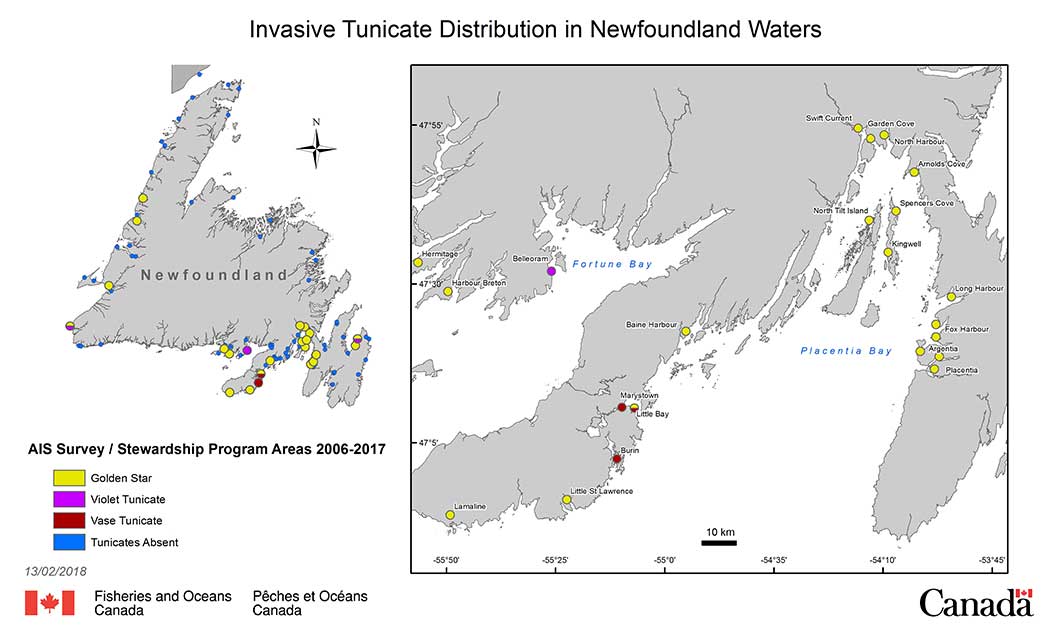Vase tunicate
Ciona intestinalis
Report it
If you think you have found an aquatic invasive species:
- take photos
- note:
- the exact location (GPS coordinates)
- the observation date
- identifying features
- contact us to report it
The vase tunicate is an invasive solitary tunicate believed to have originated in the Northeast Atlantic.
Identifying features
Vase tunicates have an elongate cylindrical, translucent soft and smooth body (often pale yellow, green or orange in color), and can grow up to 6 inches (15 cm) in length. The Vase Tunicate develops individually but can form dense aggregations. They attach to virtually any hard, natural or man-made substrate, often in large groups, making them a major bio fouling organism. They may reproduce continuously in waters above 8°C, releasing eggs and sperm which fertilize and form free-swimming larvae. Larvae must settle within 1-6 days to survive- which limits their natural dispersal to a short distance.
Similar species (native)
Among native species, sea potatoes and sea peaches are other tunicates, but they are solitary or found in small groups. The sea potato is shaped like a rattle and has a stalk that can reach 13 cm. The sea peach's body is firm and rounded and its skin is rough.
Where it has been found
Its earliest record in North America was in the eastern United States in 1850 and on the Canadian east coast (New Brunswick) in 1852. It has been intermittently documented in eastern Canada for the past 100 years. Large populations of the species have been found in Nova Scotia since 1997 and in Prince Edward Island since 2004.
In Newfoundland, Vase Tunicate was first identified on September 19, 2012, during a DFO wharf and breakwater dive survey in Burin, Placentia Bay. This is the first record of vase tunicate in Newfoundland waters. Follow-up surveys in October and November 2012 discovered vase tunicate was also present in Little Bay and Marystown. The greatest abundance was found in Little Bay on wharf pilings, boat hulls, ropes, buoys, kelp, and eelgrass blades. Smaller numbers were found in Burin and Marystown on wharf structures. The species has not been found on any Newfoundland aquaculture farm to date.
Habitat
Temperature and salinity play a major role in the growth and reproduction of vase tunicate. In temperate or shallow regions, Vase tunicates may live 12-18 months and produce two generations per year; however they may live 2-3 years and reproduce one year or less in deeper, colder areas.
Ecological and economic impacts
Since the vase tunicate is a filter feeding animal, it is a natural competitor for other filter feeders (including mussels and other commercial bivalves). Aquaculture farms in the Maritimes (particularly Nova Scotia and Prince Edward Island) have reported decreased size and condition of commercially raised mussels, increased harvesting costs due to tunicate removal, and water quality issues on fish farms. The vase tunicate is mostly composed of water, and in dense aggregations can carry substantial weight. This added weight may lead to increased maintenance cost to boaters, as well as decreased boat speed and maneuverability.
Origins and mode of arrival
The Vase Tunicate is believed to have originated from Northern Europe.
East coast
The Vase Tunicate was rare until the population outbreak that was observed in the last decade along the south coast of Nova Scotia in bays with artificial substrates such as docks, fishing vessels and aquaculture gear. This species remains absent or very rare along the eastern shore region of Nova Scotia.
West coast
The Vase Tunicate has not been yet detected of the west coast.
Mode of dissemination
Vase Tunicate regional dispersion is likely dues to hull fouling of slowmoving vessels such as floating barges, small fishing or recreational water craft within many coastal areas.
Government action
Scientific research
Research is ongoing to learn about the biology of this species in the Newfoundland environment and to develop mitigation methods and communications strategies to control and prevent its spread throughout the province.
Controlling abundance
Vase tunicate is listed as the most problematic invasive species to mussel aquaculture in the Maritime Provinces, and therefore every effort must be made to prevent the spread of the species to eastern mussel aquaculture farms.
Tunicates can be easily spread through movement of gear, shellfish, and commercial and recreational boats. To control the spread of vase tunicate, boat hulls and gear should be visually inspected and cleaned regularly by letting air dry for at least 48 hours. Care should be taken that plant and animal material and water is disposed of on land and no materials go back into the water. Antifouling paints are effective in preventing settlement of vase tunicate and should be applied regularly. Every effort should be made to remove populations from wharves and surrounding structures.
Surveys and monitoring for vase tunicate is an effective tool in early detection. Early detection of recently established populations may provide an opportunity to control, contain, or ideally eradicate new populations before they spread.
For further information
- Canadian Science Advisory Secretariat (CSAS) Publications
- Invasive Tunicate - Fact Sheet
- Identification Booklet of marine species in Eastern Canada
- Application of QBRAT for a Risk Assessment of the Invasive Tunicate Didemnum sp. in British Columbia (CSAS resdocs - 2007/056)
Research document – 2007/056– Fisheries and Oceans Canada - Aquatic Invasive Species: Vase Tunicate in Newfoundland and Labrador Waters
Fisheries and Oceans Canada - 2011 - Science advice from a risk assessment of five sessile tunicate species (CSAS SAR - 2012/049)
- Biological Synopsis of the Solitary Tunicate (Ciona intestinalis)
References
- Carver, C.E., Mallet, A.L., and Vercaemer, B. 2006a. Biological Synopsis of the Solitary Tunicate Ciona intestinalis. Can. Manuscr. Rep. Fish. Aquat. Sci. 2746: v + 55 p.
- Pollock, L.W. 1998. A practical guide to the marine animals of Northeastern North America. New Brunswick (NJ) : Rutgers University Press. 367 p.
- Sargent, P., Wells, T., Matheson, K., McKenzie, C.M., and Deibel, D. 2013. First record of vase tunicate, Ciona intestinalis (Linnaeus, 1767) in coastal Newfoundland waters. BioInvasions Records 2(2). Sous presse.
- Date modified:



